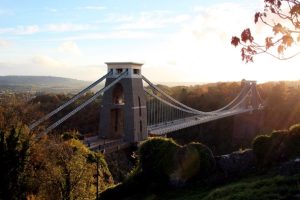To launch our brand new collaboration with History Hit and our new Clifton Suspension Bridge display, Hannah Little from Clifton Suspension Bridge has written a guest blog on how a near-death experience at the tunnel led the younger Brunel to Bristol…
In 1826 Marc Isambard Brunel’s son, Isambard Kingdom Brunel (1806-1859) was appointed as Resident Engineer for the Thames Tunnel. On 11th January 1828 the tunnel was suddenly breached and flooded. Brunel had been overseeing the night shift and was nearly drowned, but he was lucky to escape – six people died in the accident. It took several months for the breach to be filled, the tunnel drained and cleared, and for the shield to be repaired. Financial investment in the project also floundered. As a consequence, the end of the tunnel was blocked up, a large mirror placed over it to give the illusion of a complete structure, and work on the project ceased. Brunel himself was for the most part confined to his bed for several months whilst he recuperated from his internal injuries. Understandably his spirits were low: contemplating the future and writing his thoughts in his private diary, the 22-year-old imagined the complete failure of the tunnel project leading to the death of his parents, himself going off to war and being wounded, or perhaps even just becoming a “mediocre success – an engineer sometimes employed sometimes not.”
A year later Brunel’s diary shows him recovered and active – attending lectures at the Royal Society, the Geological Society, and the Humane Society and busy carrying out experiments in developing a gas engine. On 6 April 1829 he wrote:
“Here I am at Rotherhithe renewing experiments on gaz — been getting apparatus up for the last six months!! is it possible? A fortieth of the remainder of my life. What a life. The life of a dreamer. Am allways building castles in the air.”
At some point in the same year, Brunel visited Bristol in the West Country. Here was a city where a new opportunity was opening up for the young dreamer. In 1754 the Bristol merchant William Vick had set aside a sum of £1000 in his will to build a new bridge over the River Avon. By 1829 the legacy had accumulated to £8,000. The Merchant Venturers of the city decided that now was the time to set up a committee and launch a competition to find a winning design. On 1 October they advertised a competition offering 100 guineas as a prize. Because Bristol lay five miles upriver from the open sea, they specified that the bridge would have had to be built high enough to allow ships to pass underneath at high tide. As such the most suitable location for the bridge was across the top of the Avon Gorge cliffs, connecting the fashionable residences of Clifton with Somerset.
Detail of competition drawing for Clifton Suspension Bridge showing tunnels at either end of the bridge by Isambard Kingdom Brunel, Drawing number 3. 19 November 1829. DM1761/3: Brunel Institute: a collaboration between the University of Bristol and the SS Great Britain.

Detail of competition drawing for Clifton Suspension Bridge showing tunnels at either end of the bridge by Isambard Kingdom Brunel
In his own words, Brunel writes that he was “struck with the grandeur of the idea and the splendid effects which might be produced by a Bridge of this construction were it made to harmonize with scenery so peculiarly suited to such a work of Art. Fully appreciating the opportunity then offered of executing a work which must reflect such Credit upon the Engineer I determined to spare neither time nor expense in studying well the locality…”
In November 1829 he submitted several different competition entries. One of his schemes took inspiration from elements of Lancaster Castle. Another included tunnelling through rock so that the bridge emerged out of a cave and then over the gorge creating a dramatic way to travel through the landscape. All of Brunel’s designs had spans that would have made them the longest bridges in the world at that time.
Despite his ‘castles in the air’, Brunel’s efforts eventually paid off when his Egyptian design was finally approved and he was appointed as engineer for the bridge on 18 March 1831 – just a few weeks shy of his 25th birthday. Further ties with Bristol were forged when he was asked to work on improving Bristol’s floating harbour in 1832 and – perhaps the most defining point of his career – when he won the contract for the Great Western Railway in 1833. Perhaps now his fears of failure and of being a ‘mediocre’ engineer could be put to rest.

Modern view of Clifton Suspension Bridge. Image courtesy of Clifton Suspension Bridge Trust.
Find out more about the Clifton Suspension Bridge’s story by viewing the new History Hit film in our museum gallery space. Plan your visit today.
You can also visit the bridge in person and explore how it was completed by visiting Clifton Suspension Bridge’s free Visitor Centre , by booking a tour or by searching through its history online.

